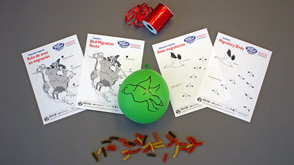Migration Challenge
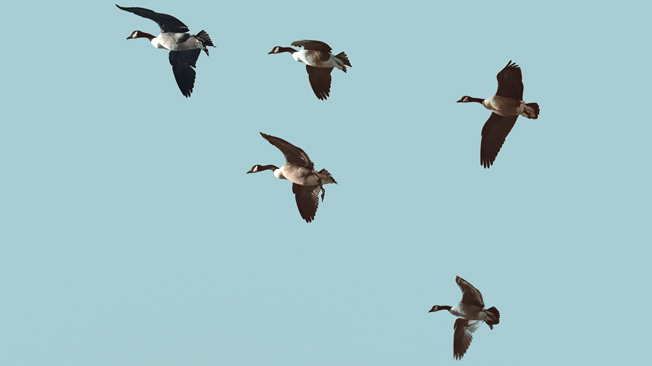
What Is This Activity?
What challenges do birds face as they migrate through cities and towns in search of food, water, and shelter? Kids role-play migrating birds in three games.
Introduction
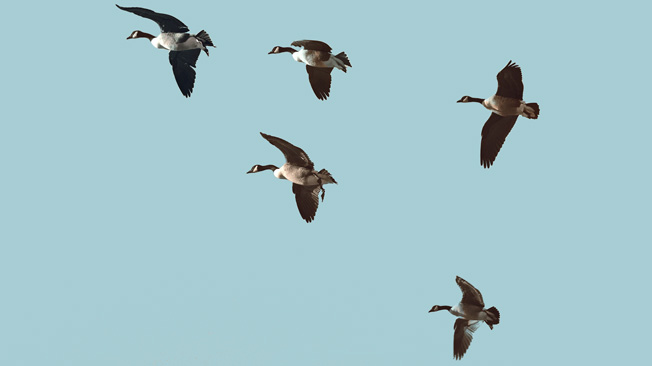
Learning Goals
Big Science Idea:
- Birds that migrate (fly long distances) depend on food, water, and shelter along the way to survive.
Skills kids will use to investigate the idea:
- Model a flock of migrating birds
- Identify, model, and communicate the advantages and disadvantages of traveling in groups and through cities
- Discuss solutions for reducing migration hazards
How Do You Get Ready?
- Read the activity and gather the materials.
- Print out the "Migratory Birds" handout. Also print the "Bird Migration Route" handouts, or identify a bird that's common to your area. Audubon's Guide to North American Birds provides more examples.
- Scout out a playing area, such as a park, schoolyard, basketball court, or other open area. Troubleshoot safety concerns (traffic, poison ivy, sharp objects, etc.).
- For "The Migration Game," you will need equal amounts of pasta (or beans) in three colors, and roughly three times as many pieces as you have kids. Choose one color to represent "water," another color to represent "food," and the third color to represent "city and town hazards." Set out 10 to 12 small piles of mixed-color pasta (or beans) around the playing area. These represent stopover areas for birds. Mark with ribbons the "north" and "south" ends of the open area.
- If you don't plan to show the "Cities Vs. Plants" video that is paired with this activity on the website, watch it ahead of time and jot down concepts to share with kids during the activity.
Warm-up 10 minutes
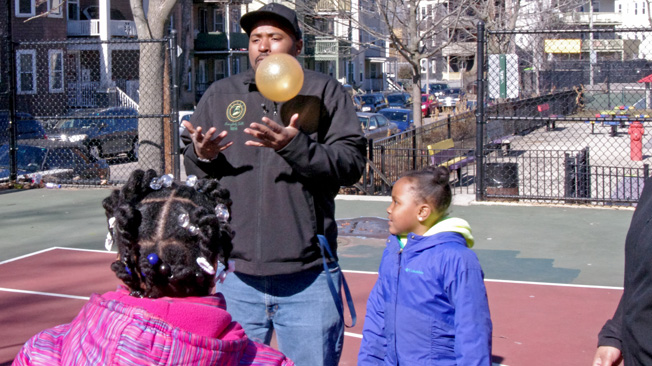
(Science Skills: Model a migrating bird)
- Air Bird Game! The goal is to fly a "bird" (a balloon) to a new home without letting it drop.
- Players form a line with several feet of space between each person.
- The first player tosses the bird up and bats it toward the next player. Only one person can touch the ball at a time.
- Each player, in turn, bats the balloon one person forward. (Expect a little chaos and erratic movement.)
- If the bird drops to the ground before the line is complete, start over.
- Ask: Did our bird make it to its new home? Tell the kids that they will be playing games that help them understand how and why birds move from one location to another.
Activity 30-40 minutes
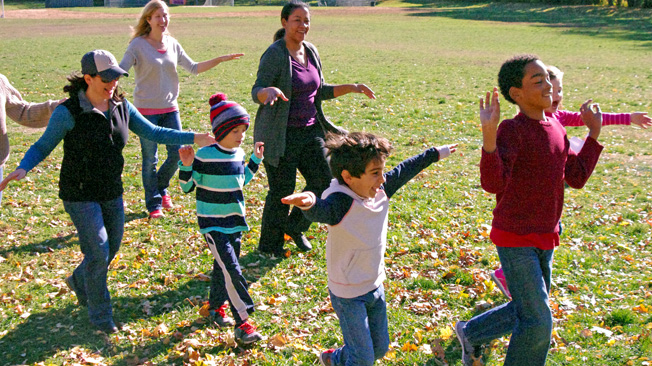
Flocking Together
(15-20 minutes)
(Science Skills: Model a flock of migrating birds; identify, model, and communicate the advantages and disadvantages of migrating in groups)
- Ask: Do you see any birds today? Why do they fly over your city or town? Where do you think they are going, and why? (Seeking a home in parks, fields, and other outdoor spaces; looking for food, water, shelter, and safety.)
- Introduce the science term migration. Explain that some animals, especially birds, move far away to a new location. This movement, called migration, is often seasonal, meaning that animals spend part of the year in one location and part of the year in a different location. Ask: Why do you think birds migrate? (To find better climate, more food, breeding grounds.) What if a bird can't migrate the whole distance in a single day? (It will have to stop somewhere to sleep or rest.) Are cities good or bad places for migrating birds to stop and rest? Why do you think that? (Accept most answers, including dangers such as traffic, and revisit this question later.)
- Be free as a bird: Allow kids a few minutes to pretend to be a flock of birds, "flying" around however they like and interacting—or not. After a minute or two, join them and encourage kids to follow your lead, honking like a goose. Take mental note: How many kids fall in line behind you? Do they stay there or fall behind or fly off? Single file or not? Do they imitate your honks—or do their own thing?
- Discuss: Talk about what you observed and then describe how geese fly in formation, as a unit. Show kids the "Migratory Birds" handout with the birds flying in "V" formation—with a leader at the head and other birds behind it in two angled lines. Ask: What do you think it's like to fly in a large flock? To be the leader?
- Divide the group in half and choose two older or more mature children to be leaders. Have each group pretend they are migrating geese flying in "V" formation. Expect some confusion at first! Let kids figure out how to communicate and coordinate movements. It's also okay if "birds" fly off on their own—a point of discussion later.
- When a flock achieves a "V" formation, ask a new leader to take the lead position "in flight." Can the group stay in formation while moving? How fast can they travel together? How do their arms feel? Do any birds fall off pace? Or break formation for other reasons?
- Discuss: What are advantages of birds traveling in a very large group? (Safety in numbers since more birds means each individual bird has less of a chance of falling prey to a predator, harder to get lost, social bonding, etc.) Disadvantages? (Slower going and large numbers of birds need more food and water than one bird.)
- Explain that a big advantage for geese is they spend less energy flying. The leader cuts through the wind and creates a forward-moving draft that reduces wind resistance for the followers. (Long-distance bikers, swimmers, runners, and skiers also take advantage of drafting behind a leader to save energy.) When the leader tires, the bird drops back and another bird takes the lead.
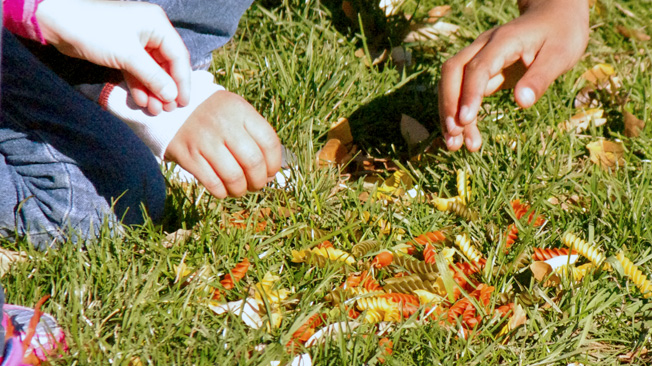
The Migration Game
(15-20 minutes)
(Science Skills: Model a flock of migrating birds; identify, model, and communicate the advantages and disadvantages of migrating through cities)
- Pass out the "Bird Migration Route" handout. Briefly discuss: Where do migrating birds go? For example, snow geese fly north in the spring, to Arctic Canada, and south in the fall, to Texas and other southern U.S. states.
- In this simulation game, kids role-play a flock of birds migrating through a city or town. If you like, choose a bird a common local bird that migrates through your area for the kids to imitate. Introduce the bird's name, picture, and migration route.
- The group starts at the "north" side of the open area and, on your signal, "migrates" to the "south." Along the way, each bird must pick up one "food" and one "water" (colored pasta or beans; see "How Do You Get Ready?") at each stopover point (small pile of pasta or beans). They should not pick up the color that represents "danger."
- Reverse the migration—south to north. Again, the goal is to collect food and water, but now there are fewer resources. Continue until some "birds" can't find enough food and water—similar to a "Musical Chairs" game.
- Discuss: Based on your experience in this game, what makes a good stopping point for a migrating bird? (Places with lots of food and water and little danger.) Would our city (or town) make a good stopover point for a migrating bird? Why or why not? (Cities and towns offer some stopover sites that provide food, water, and shelter, but pavement and buildings limit these resources; in addition, window collisions, traffic, power lines, predators, and pollution can all be dangerous to birds.)
Wrap-up 10 minutes
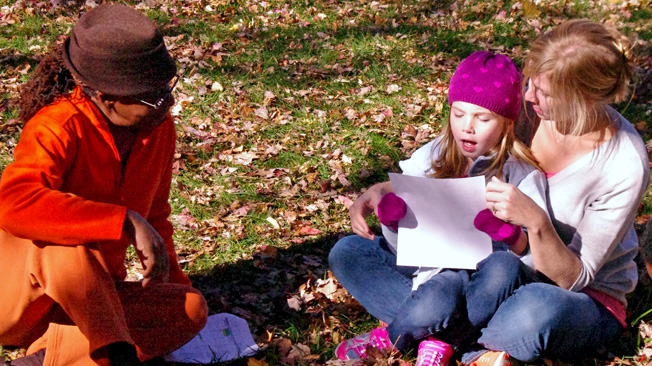
(Science Skills: Discuss solutions to reduce migration hazards)
- Ask: What did you think of the game? Have you seen migrating birds in the area, or do you know of any that migrate? What time of year? Where do you think they were heading next?
- Discuss: How could people make cities and towns better places for migratory animals? If kids struggle to think of ideas, remind them of a specific problem: Not enough water for the whole flock, crashing into windows, or too much traffic and too many people, for example. (Some solutions could include more open or green spaces, ponds or fountains to provide water, stickers on windows so that birds can see them, and so on.)
- If you haven't already, send home the "Explore Animals Around You" handout to provide families with ideas on how to continue investigating animals together.
Explore Some More
Migration Maps
Have kids walk around and survey the immediate area for possible bird stopover sites—places with water, food, and safe areas for birds to rest. Have them make a list or draw a simple map to show the stopover locations. They can also list or add hazards to their map—high traffic areas, windows to collide with, power lines, etc.
- Optional: Explore Audubon's Guide to North American Birds and a map of migratory routes to identify other species together. The eBird website has interactive migration maps.
- Optional: Kids can play the "inner city" mode of Audubon's Mission Migration online game to learn more about hazards. (Flash required)
Explorer's Notebook
Use the template provided: Give kids a few minutes to explore your outdoor space and take notes about and sketch a bird that catches their eye. Guiding questions:
- What color is it? Where did you see it? What was it doing? What do you think it eats? How big is it? (e.g., "bigger than a cat," "smaller than a piece of bread") Ask: Is this a bird you see all the time? Do you think it lives in this area or is just migrating through? Where do you think it might be heading?
- Optional: Identify birds in regional nature guides, such as Cornell's Merlin Bird ID app or Audubon's Guide to North American Birds, and have kids draw and describe them.

